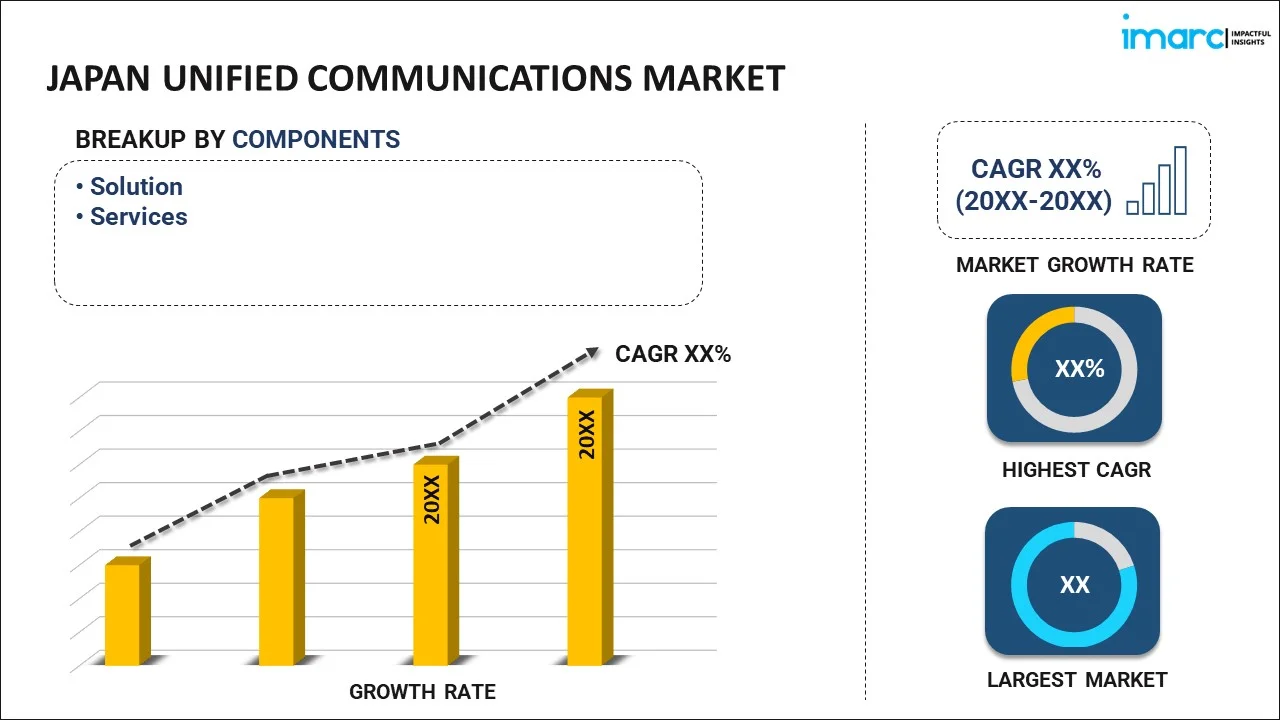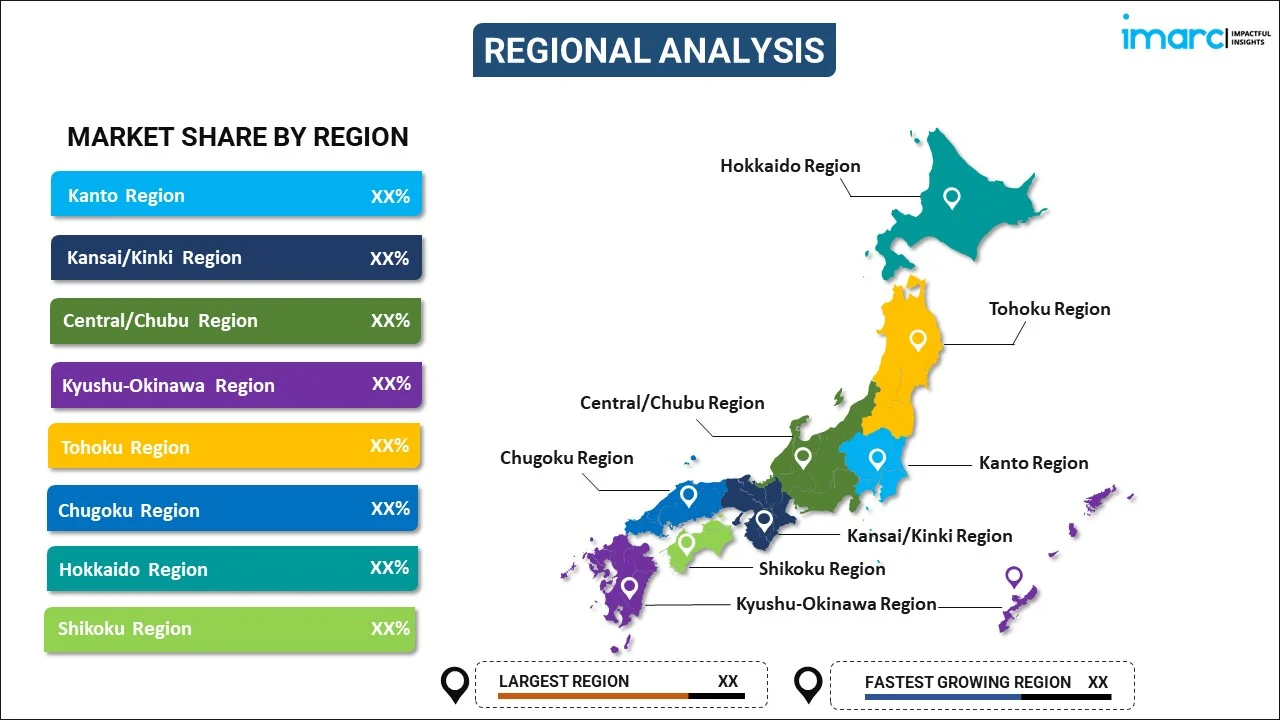
Japan Unified Communications Market Report by Component (Solution, Services), Product (On-premises, Hosted), Organization Size (Small and Medium-sized Enterprises, Large Enterprises), End User (Enterprises, Education, Government, Healthcare, and Others), and Region 2025-2033
Market Overview:
Japan unified communications market size reached USD 4.5 Billion in 2024. Looking forward, IMARC Group expects the market to reach USD 24.6 Billion by 2033, exhibiting a growth rate (CAGR) of 18.7% during 2025-2033. The emerging shift towards remote work and the increasing prevalence of distributed teams, coupled with the rising need for reliable communication tools that enable seamless collaboration regardless of location, is primarily driving the market.
|
Report Attribute
|
Key Statistics
|
|---|---|
|
Base Year
|
2024 |
|
Forecast Years
|
2025-2033
|
|
Historical Years
|
2019-2024
|
| Market Size in 2024 | USD 4.5 Billion |
| Market Forecast in 2033 | USD 24.6 Billion |
| Market Growth Rate (2025-2033) | 18.7% |
Unified communications (UC) is a transformative technology that has revolutionized the way businesses communicate and collaborate in the modern digital age. At its core, UC integrates various communication tools and channels into a single, cohesive platform, breaking down the barriers between voice, video, messaging, and data sharing. With UC, organizations can streamline their communication processes, enhancing productivity and efficiency. Team members can effortlessly switch between instant messaging, video conferencing, and traditional phone calls within a unified interface, reducing communication silos and simplifying the user experience. This helps to save time and reduce the chances of missed messages or misunderstandings. Furthermore, UC enables real-time collaboration regardless of distance. Teams can work seamlessly from different locations, fostering remote work and boosting flexibility. Moreover, UC solutions often include robust features like file sharing, screen sharing, and presence indicators, promoting better decision-making and problem-solving.
Japan Unified Communications Market Trends:
The unified communications market in Japan is powered by several interconnected factors that propel the industry forward. Firstly, the growing demand for remote work solutions has been a significant driver. As businesses adapt to flexible work arrangements, the need for seamless communication and collaboration tools has surged. This trend is further amplified by the evolution of technology, exemplified by the proliferation of 5G networks, which enable high-quality, real-time communication. Moreover, the increasing importance of cost efficiency acts as a compelling motivator. UC solutions streamline communication processes, reducing the need for multiple disparate tools. Consequently, organizations can optimize their resources and cut down on expenses, a particularly attractive proposition in a competitive market. Apart from this, the imperative integration of customer relationship management (CRM) tools and data analytics with UC that empowers organizations to deliver personalized services efficiently and meet customer expectations is expected to drive the unified communications market in Japan during the forecast period.
Japan Unified Communications Market Segmentation:
IMARC Group provides an analysis of the key trends in each segment of the market, along with forecasts at the country level for 2025-2033. Our report has categorized the market based on component, product, organization size, and end user.
Component Insights:

- Solution
- Instant and Unified Messaging
- Audio and Video Conferencing
- IP Telephony
- Others
- Services
- Professional Services
- Managed Services
The report has provided a detailed breakup and analysis of the market based on the component. This includes solution (instant and unified messaging, audio and video conferencing, IP telephony, and others) and services (professional services and managed services).
Product Insights:
- On-premises
- Hosted
A detailed breakup and analysis of the market based on the product have also been provided in the report. This includes on-premises and hosted.
Organization Size Insights:
- Small and Medium-sized Enterprises
- Large Enterprises
The report has provided a detailed breakup and analysis of the market based on the organization size. This includes small and medium-sized enterprises and large enterprises.
End User Insights:
- Enterprises
- Education
- Government
- Healthcare
- Others
A detailed breakup and analysis of the market based on the end user have also been provided in the report. This includes enterprises, education, government, healthcare, and others.
Regional Insights:

- Kanto Region
- Kansai/Kinki Region
- Central/ Chubu Region
- Kyushu-Okinawa Region
- Tohoku Region
- Chugoku Region
- Hokkaido Region
- Shikoku Region
The report has also provided a comprehensive analysis of all the major regional markets, which include Kanto Region, Kansai/Kinki Region, Central/ Chubu Region, Kyushu-Okinawa Region, Tohoku Region, Chugoku Region, Hokkaido Region, and Shikoku Region.
Competitive Landscape:
The market research report has also provided a comprehensive analysis of the competitive landscape. Competitive analysis such as market structure, key player positioning, top winning strategies, competitive dashboard, and company evaluation quadrant has been covered in the report. Also, detailed profiles of all major companies have been provided. Some of the key players include:
- Avaya LLC
- Cisco Systems Inc.
- NEC Corporation (AT&T Inc.)
- Vonage (Telefonaktiebolaget LM Ericsson)
(Please note that this is only a partial list of the key players, and the complete list is provided in the report.)
Japan Unified Communications Market Report Coverage:
| Report Features | Details |
|---|---|
| Base Year of the Analysis | 2024 |
| Historical Period | 2019-2024 |
| Forecast Period | 2025-2033 |
| Units | Billion USD |
| Scope of the Report | Exploration of Historical Trends and Market Outlook, Industry Catalysts and Challenges, Segment-Wise Historical and Future Market Assessment:
|
| Components Covered |
|
| Products Covered | On-premises, Hosted |
| Organization Sizes Covered | Small and Medium-sized Enterprises, Large Enterprises |
| End Users Covered | Enterprises, Education, Government, Healthcare, Others |
| Regions Covered | Kanto Region, Kansai/Kinki Region, Central/ Chubu Region, Kyushu-Okinawa Region, Tohoku Region, Chugoku Region, Hokkaido Region, Shikoku Region |
| Companies Covered | Avaya LLC, Cisco Systems Inc., NEC Corporation (AT&T Inc.), Vonage (Telefonaktiebolaget LM Ericsson), etc. |
| Customization Scope | 10% Free Customization |
| Post-Sale Analyst Support | 10-12 Weeks |
| Delivery Format | PDF and Excel through Email (We can also provide the editable version of the report in PPT/Word format on special request) |
Key Questions Answered in This Report:
- How has the Japan unified communications market performed so far and how will it perform in the coming years?
- What has been the impact of COVID-19 on the Japan unified communications market?
- What is the breakup of the Japan unified communications market on the basis of component?
- What is the breakup of the Japan unified communications market on the basis of product?
- What is the breakup of the Japan unified communications market on the basis of organization size?
- What is the breakup of the Japan unified communications market on the basis of end user?
- What are the various stages in the value chain of the Japan unified communications market?
- What are the key driving factors and challenges in the Japan unified communications?
- What is the structure of the Japan unified communications market and who are the key players?
- What is the degree of competition in the Japan unified communications market?
Key Benefits for Stakeholders:
- IMARC’s industry report offers a comprehensive quantitative analysis of various market segments, historical and current market trends, market forecasts, and dynamics of the Japan unified communications market from 2019-2033.
- The research report provides the latest information on the market drivers, challenges, and opportunities in the Japan unified communications market.
- Porter's five forces analysis assist stakeholders in assessing the impact of new entrants, competitive rivalry, supplier power, buyer power, and the threat of substitution. It helps stakeholders to analyze the level of competition within the Japan unified communications industry and its attractiveness.
- Competitive landscape allows stakeholders to understand their competitive environment and provides an insight into the current positions of key players in the market.
Need more help?
- Speak to our experienced analysts for insights on the current market scenarios.
- Include additional segments and countries to customize the report as per your requirement.
- Gain an unparalleled competitive advantage in your domain by understanding how to utilize the report and positively impacting your operations and revenue.
- For further assistance, please connect with our analysts.
 Inquire Before Buying
Inquire Before Buying
 Speak to an Analyst
Speak to an Analyst
 Request Brochure
Request Brochure
 Request Customization
Request Customization




.webp)




.webp)












